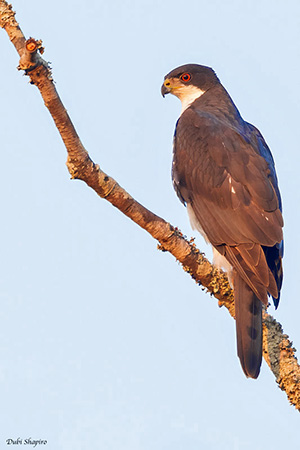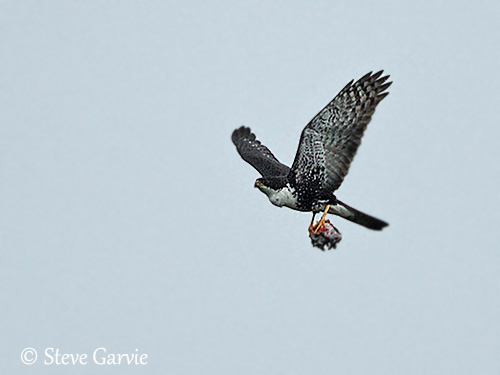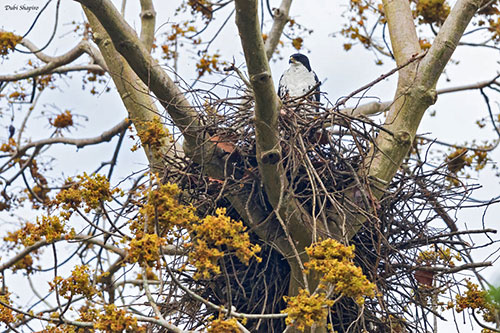
The female lays 2-4 greenish to greenish-white eggs with darker markings. The incubation lasts 34-38 days and is mainly by the female, but the male may incubate sometimes after bringing a prey to the female which eats the food and also bathes in a nearby stream. Then, she returns to the nest.
The chicks are brooded by the female for the first three weeks and then, she joins the male on hunting trips. At 35-40 days old, the young clamber around the nest-site, and they leave the site some days later. They still depend on adults for further 40-60 days. Then, the adults leave the area and the young are forced to become fully independent.
PROTECTION / THREATS / STATUS:
The Black Sparrowhawk is widespread and common.
The size of the population is unknown, but it is suspected to be declining, due to habitat loss and use of pesticides, although being adapted to exotic plantations in Southern Africa. But the Black Sparrowhawk is not globally threatened, and the species is currently evaluated as Least Concern.
Fr: Autour noir
Ang: Black Sparrowhawk, Great Sparrowhawk, Black Goshawk
All: Dominohabicht
Esp: Azor Blanquinegro
Ita: Astore nero
Nd: Zwarte Havik
Sd: svart duvhök
Photographers:
Steve Garvie
RAINBIRDER Photo galleries & Flickr Rainbirder
Dubi Shapiro
Dubi Shapiro Photo Galleries
Text by Nicole Bouglouan
Sources:
HANDBOOK OF THE BIRDS OF THE WORLD Vol 2 by Josep del Hoyo-Andrew Elliot-Jordi Sargatal - Lynx Edicions - ISBN: 8487334156
BIRDS OF AFRICA SOUTH OF THE SAHARA by Ian Sinclair and Peter Ryan - Princeton University Press Princeton and Oxford - ISBN: 0691118159
BIRDS OF PREY OF AFRICA AND ITS ISLANDS by Alan and Meg Kemp - Struik Publishers - ISBN: 1770073698
ROBERTS BIRDS OF SOUTH AFRICA by G. R. Mc Lachlan and R. Liversidge – The Trustees of the John Voelcker Bird Book Fund – ISBN: 0620031182
BREEDING THE BLACK SPARROW HAWK ACCIPITER MELANOLEUCUS IN CAPTIVITY
The Peregrine Fund – World Centre for Birds of Prey
Black Sparrowhawk (or Great Sparrowhawk or Black Goshawk)
Accipiter melanoleucus
Accipitriformes Order – Accipitridae Family
INTRODUCTION:
The Black Sparrowhawk is common in Sub-Saharan Africa where it frequents forest and woodland, grassland, cultivated areas and suburbia. Two subspecies share the wide range.
This black-and-white raptor occurs in normal and melanistic morph.
The Black Sparrowhawk feeds mainly on several bird species caught from perch or by low flight. The main prey are doves and pigeons, but ground birds such as francolins are also part of the diet. It may also kill other hawks and owls.
This species nests in a large structure made with sticks and lined with greenery. It is built by both adults in a fork in tall tree. Both mates share the nesting duties.
The Black Sparrowhawk is described as common and widespread, but some declines are caused by habitat loss and use of pesticides. But currently, the species is not globally threatened.
DESCRIPTION OF THE BIRD:
Biometrics:
Length: 40-58 cm
Wingspan: 77-105 cm
Weight: M: 430-490 g – F: 650-790 g
The Black Sparrowhawk adult of nominate race in normal morph has black upperparts including wings and tail. An indistinct black and dark grey barring is visible on upperwing and uppertail.
The underparts are white, except for black spots on flanks and armpit. Flight-feathers and rectrices are black with white barring.

The head is black with white chin and throat.
The bill is black with yellow cere. The eyes are red/wine-red, surrounded by thin, yellowish eyering and we can see a fine yellow eyebrow just above the eye. Bare legs and feet are yellow with black claws.
The Black Sparrowhawk in melanistic morph is all-black, except for the white throat and lower belly. We can see sometimes an indistinct white crescent on the breast. The barring on wings and tail is dark grey and white.
This morph exists only in the nominate race.
The female has similar plumage, but she is about 14% larger than male.
The juvenile also occurs in two morphs. The upperparts are brown. Head and rump are streaked black-and-white. Rest of upperparts is darker brown with broad, rufous feather edges.
The underparts vary from deep rufous to white, with variable fine to broad dark brown streaks.
The juvenile female is usually paler and less streaked.
The young birds have brown eyes when they fledge, but they soon turn grey and then yellow. The bill is black with dull olive cere.
SUBSPECIES AND RANGE:
The Black Sparrowhawk has two subspecies.
A.m. melanoleucus (described above) is found in E Sudan, Eritrea, N and W Ethiopia and E Africa, S to Angola, Namibia and E and S South Africa.
The melanistic morph is most frequent in South Africa.
A.m. temminckii is a non-breeding visitor in Senegambia. It is found in E to Central African Republic and W DRCongo.
This race is smaller than nominate, with more mottled flanks
HABITAT:
The Black Sparrowhawk frequents forested habitats from extensive tropical lowland forest to patches of montane or riverine forests. It is also found now in exotic plantations.
It also frequents Acacia savanna and miombo (Brachystegia) woodlands. It may occur in grassland, agricultural areas and suburbia.
The species is visible from sea-level up to 3,700 metres of elevation.
CALLS AND SONGS: SOUNDS BY XENO-CANTO
The Black Sparrowhawk is noisy at nest and generally during the breeding season.
It utters a drawn-out whistling and shrill yelping calls. The pair may duet prior to the egg-laying, with the male giving a high-pitched “kyip” and the female a deeper “chep”.
If the female is disturbed at nest, she produces a loud “kow-kow-kow-kow-kow” and when the male brings prey to the nest, it gives a “kyip” call.
BEHAVIOUR IN THE WILD:
The Black Sparrowhawk feeds on birds such as doves and pigeons, but the larger female can catch birds as big as Francolin and Vulturine Guineafowl. But smaller prey like starlings are also part of the diet.
This raptor hunts by sitting quietly in tree, waiting for flocks of birds. Then, it swoops down on them.
But it also hunts by flying low over the ground while trying to flush a bird. To catch pigeons and doves on the wing is much more difficult because Columbidae are very good fliers.
However, the best way to catch a prey is taking off from the ground or from a low perch, before swooping down on the prey.

The Black Sparrowhawk is monogamous and the pair-bond is for life. However, extra-pair copulations are observed.
They nest in a large structure made with sticks, built high up in tree canopy in forest or plantation.
The nesting pair usually mates regularly during the breeding season, from the courtship period to the post-fledgling period. The male provides all the food during the incubation and the nesting period. Then both adults hunt together for their young.
The Black Sparrowhawk is resident and territorial. It may colonize new areas such as plantations in grassland or savanna, undertaking long distance flights.
The juveniles move up to 145 kilometres in S Africa.
The species may also be locally migratory in W and NE Africa.
The Black Sparrowhawk flies straight and fast over the country, whereas it twists and turns when flying through the vegetation. It flies with fast, strong wingbeats.
REPRODUCTION OF THIS SPECIES:
The race “A.m. temminckii” breeds generally from August to November, whereas the nominate race breeds between May and October.
The large stick nest is built by both adults within the tree canopy. This situation protects the nest and the young from bad weather and predators.
The nest can be placed from 7 to 36 metres high in tree, in close proximity of the hunting habitat outside of the forest.
Both adults collect thousands of sticks to build the large structure (50-70 cm wide and 30-75 cm deep. The nest is lined inside with green leaves, pine needles and other aromatic greenery, probably to avoid mites and insects. The nest is often reused year after year.
